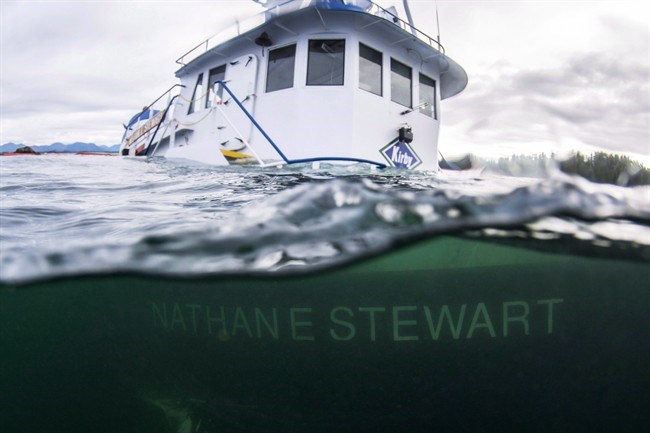 The tugboat Nathan E. Stewart is seen in the waters of the Seaforth Channel near Bella Bella, B.C., in an October 23, 2016, handout photo. Results are expected today from an investigation into what caused a tugboat to crash and sink off British Columbia’s coast in 2016, spilling thousands of litres of fuel into the ocean. THE CANADIAN PRESS/HO-Heiltsuk First Nation, April Bencze.
The tugboat Nathan E. Stewart is seen in the waters of the Seaforth Channel near Bella Bella, B.C., in an October 23, 2016, handout photo. Results are expected today from an investigation into what caused a tugboat to crash and sink off British Columbia’s coast in 2016, spilling thousands of litres of fuel into the ocean. THE CANADIAN PRESS/HO-Heiltsuk First Nation, April Bencze.
The Transportation Safety Board says the second mate on a tug that ran aground off Vancouver Island missed a planned change of course because he fell asleep while he was alone on watch.
About 107,000 litres of diesel and more than 2,200 litres of lubricants, including gear and hydraulic oils, leaked into the Pacific Ocean after the Nathan E. Stewart ran aground in October 2016.
The second mate had been working a schedule that didn't allow for sufficient rest while off duty, the board said Thursday.
The safety board is recommending that watchkeepers be trained to help identify and prevent the risks of fatigue, and that all vessel owners have fatigue-management plans tailored to individual operators.
It says fatigue has been identified as a "casual or contributory factor" in a number of marine accidents.
"There is a compelling need for vessel operators and watchkeepers to recognize and to address the factors that contribute to fatigue," board chair Kathy Fox said in a statement.
The report also said spill response and recovery efforts were within prescribed time standards, but there was some confusion about who had authority over the operation.
The 30-metre tug hit rocks and partially sank near Bella Bella while it was towing an empty barge.
Chief Marilyn Slett of the nearby Heiltsuk First Nation has said the fuel spill forced the closure of prime seafood harvesting and fishing areas and has had devastating social, cultural and economic impacts on her people.
The board said keeping watch alone on the bridge of the Nathan E. Stewart was contrary to Canadian regulations. It said the second mate had been alternating between six hours on duty and six hours of rest for more than two days.
"This schedule presents a number of challenges which have been well documented by various studies and experts internationally, notably the difficulty in obtaining sufficient restorative rest during the off-duty periods," the board said in a news release.
The U.S. National Transportation Safety Board released a report in November saying the tug's second mate told investigators he missed a change of course after falling asleep, which the board said was the probable cause of the vessel running aground.
The U.S. report said Houston-based Kirby Offshore Marine had ineffectively implemented safety management procedures, which contributed to the accident involving its tug.
It also said there was a lack of documentation on safety rounds and no evidence that safety management rules were implemented on board the Nathan E. Stewart.


